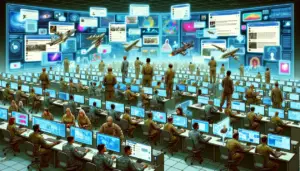
Introduction:
- As elections worldwide become increasingly digital, the use of artificial intelligence (AI) in generating disinformation poses significant challenges to the integrity of democratic processes.
Magnifying Disinformation:
- Artificial intelligence (AI) represents a double-edged sword in the realm of election disinformation.
- While it offers promising advancements in various fields, its misuse has profound implications for democratic processes.
- One of the most alarming aspects of AI is its ability to magnify the scale of disinformation by orders of magnitude.
- Unlike traditional methods of spreading false narratives, AI algorithms can churn out thousands of deceptive messages in a matter of seconds.
- This capability poses a grave threat to the democratic process, inundating voters with a deluge of misleading information designed to manipulate opinions and sway electoral outcomes. The sheer volume and speed at which AI-generated disinformation can proliferate surpass previous challenges, demanding urgent attention and innovative solutions from policymakers, technology companies, and civil society.
Artificial Intelligence Fuels the Rise of Deep Fakes

- Another concerning trend exacerbated by Artificial intelligence is the proliferation of hyper-realistic deep fakes.
- These sophisticated manipulations of images, audio, and video content blur the lines between reality and fabrication, making it increasingly difficult for voters to discern truth from falsehood.
- Unlike traditional forms of misinformation, deep fakes can deceive even the most discerning individuals, as they mimic real-life scenarios with uncanny accuracy.
- Moreover, deep fakes have the potential to spread virally on social media platforms before undergoing rigorous fact-checking, amplifying their impact on public perception and electoral outcomes.
- As the technology behind deep fakes continues to evolve, combating their influence poses a formidable challenge that requires collaboration between technology experts, media organizations, and policymakers.
Microtargeting Vulnerabilities
- The third dimension of Artificial intelligence -driven election disinformation lies in microtargeting, a practice that enables the precise dissemination of deceptive messages to specific demographic groups.
- Leveraging sophisticated algorithms, bad actors can tailor their propaganda to exploit the vulnerabilities and biases of target audiences, amplifying the polarization of political discourse and undermining the integrity of electoral processes.
- Microtargeting not only facilitates the spread of disinformation but also exacerbates social divisions, eroding trust in democratic institutions and fostering a climate of uncertainty and mistrust.
Challenges in Regulation:
- Addressing the challenges posed by Artificial Intelligence -driven disinformation requires robust regulatory frameworks that balance the need for freedom of expression with the imperative of protecting democratic values.
- However, recent reductions in fact-checking and election integrity efforts by social media platforms have exacerbated the problem, leaving a regulatory void that bad actors are quick to exploit.
- While some platforms have implemented measures such as labelling Artificial Intelligence -generated content, these initiatives alone are insufficient to curb the spread of disinformation effectively.
- Governments must take proactive steps to strengthen regulatory frameworks, empower independent fact-checkers, and hold technology companies accountable for their role in combating election disinformation.
Proactive Measures in India:
- In India, the government has taken a proactive approach to combatting AI-driven election disinformation.
- By calling on digital platforms to implement technical solutions to weed out harmful content and proposing a forthcoming legal framework to address the threat posed by deep fakes and disinformation, policymakers are taking concrete steps to safeguard the integrity of the electoral process.
- However, addressing the multifaceted challenges of AI-driven disinformation requires collaboration between government, technology companies, and civil society organizations.
- Only by working together can we develop comprehensive strategies to mitigate the impact of AI-driven election disinformation and uphold democratic principles worldwide.
Conclusion
- As the threat of AI-driven election disinformation continues to evolve, it is imperative that stakeholders remain vigilant and proactive in safeguarding the integrity of democratic processes.
- By recognizing the three-fold peril of AI-driven disinformation, implementing robust regulatory frameworks, and fostering collaboration between government, technology companies, and civil society, we can mitigate the impact of malicious AI activities and uphold democratic principles worldwide.
- Only by working together can we navigate the challenges posed by AI-driven election disinformation and ensure that democratic processes remain free, fair, and transparent for all.
People also ask
Q1: What is AI-generated disinformation?
Ans: AI-generated disinformation refers to false or misleading information created or disseminated by artificial intelligence algorithms. These algorithms can generate text, images, audio, and video content that mimic real human communication, making it difficult to distinguish between genuine and fabricated information.
Q2: How does AI accelerate the production and dissemination of election disinformation?
Ans: AI accelerates the production and dissemination of election disinformation in several ways. Firstly, it can generate false narratives at an unprecedented scale, reaching thousands of people within seconds. Secondly, AI can create hyper-realistic deep fakes, such as manipulated images and videos, which can influence voters before they can be fact-checked. Thirdly, AI enables microtargeting, allowing disinformation to be tailored to specific demographic groups, increasing its effectiveness in persuading people to vote in a certain way.
Q3: What are deep fakes, and how do they impact elections?
Ans: Deep fakes are highly realistic manipulated videos or images created using AI algorithms. These creations can be used to spread false information, manipulate public opinion, and discredit political opponents during elections. Deep fakes pose a significant threat to electoral integrity as they blur the lines between truth and fiction, making it challenging for voters to discern genuine content from fabricated ones.
Your point of view caught my eye and was very interesting. Thanks. I have a question for you.